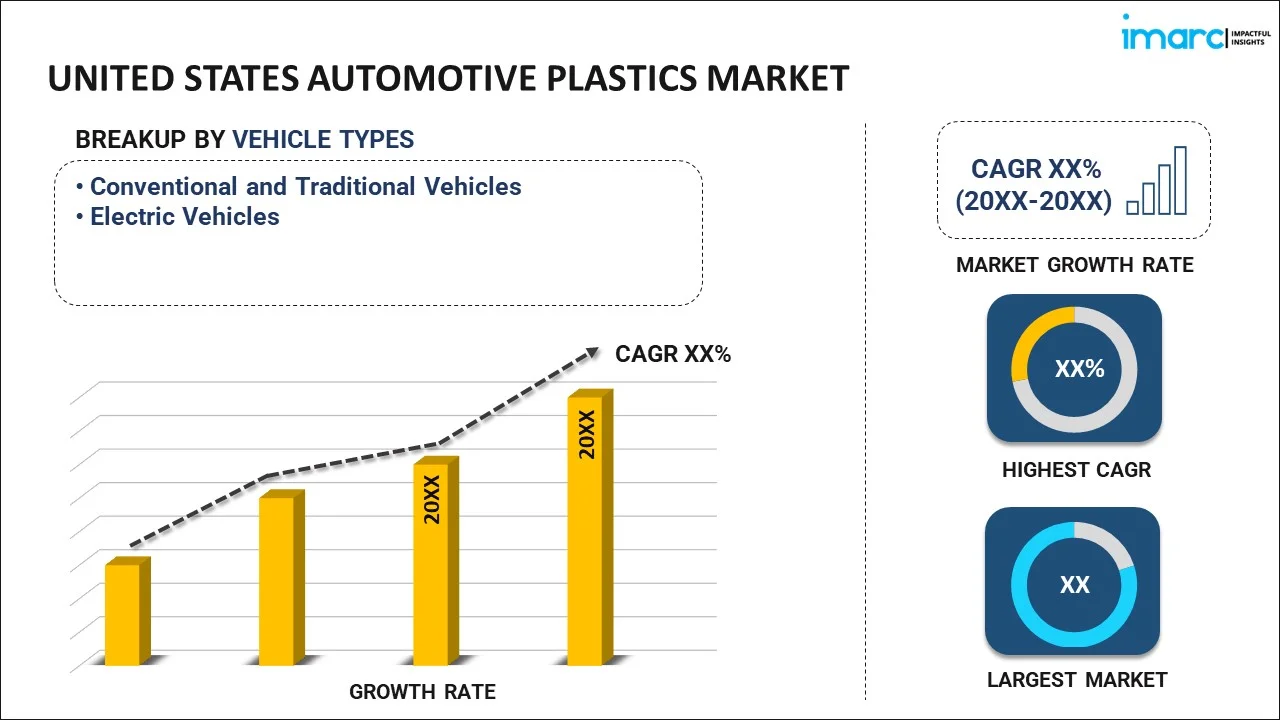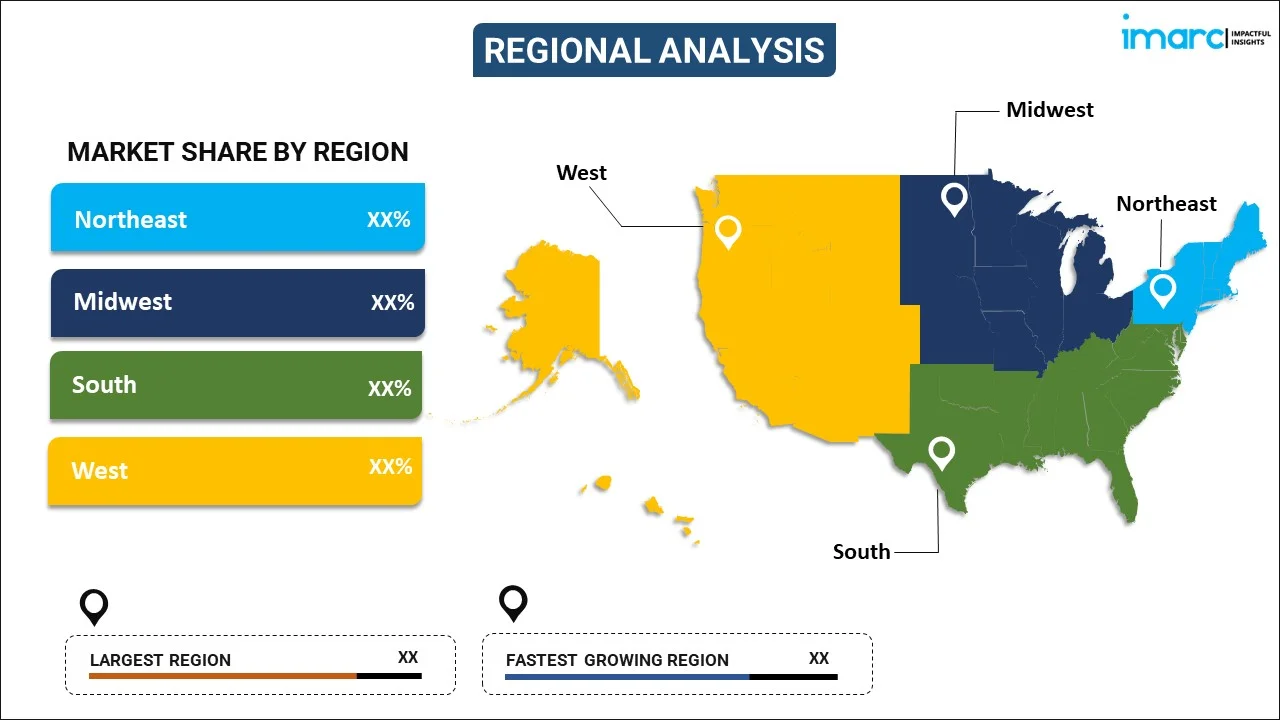
United States Automotive Plastics Market Report by Vehicle Type (Conventional and Traditional Vehicles, Electric Vehicles), Material (Polyethylene (PE), Polypropylene (PP), Polyvinyl Chloride (PVC), Acrylonitrile Butadiene Styrene (ABS), Polyurethane (PU), Polymethyl Methacrylate (PMMA), Polycarbonate (PC), Polyamide, and Others), Application (Powertrain, Electrical Components, Interior Furnishings, Exterior Furnishings, Under the Hood, Chassis), and Region 2024-2032
Market Overview:
United States automotive plastics market size reached US$ 7.35 Billion in 2023. Looking forward, IMARC Group expects the market to reach US$ 19.2 Billion by 2032, exhibiting a growth rate (CAGR) of 11.10% during 2024-2032. The escalating demand for lightweight and the growing usage of bio-based polymers by leading players to reduce their carbon footprint and promote sustainability represent some of the key factors driving the market growth across the country.
|
Report Attribute
|
Key Statistics
|
|---|---|
|
Base Year
|
2023
|
|
Forecast Years
|
2024-2032
|
|
Historical Years
|
2018-2023
|
|
Market Size in 2023
|
US$ 7.35 Billion |
|
Market Forecast in 2032
|
US$ 19.2 Billion |
| Market Growth Rate 2024-2032 | 11.10% |
Automotive plastics encompass a variety of materials, including polypropylene (PP), polyurethane (PU), polyvinyl chloride (PVC), acrylonitrile butadiene styrene (ABS), nylon, polyethylene (PE), polyoxymethylene (POM), and polycarbonate (PC). These polymers play a crucial role in enhancing the durability of automobiles, providing greater design versatility, lowering production expenses, and facilitating the integration of components. Additionally, automotive plastics contribute to the reduction of vehicle weight by substituting heavier materials like metal and glass. This not only aids in energy conservation but also enhances fuel efficiency. In essence, the use of automotive plastics represents a multifaceted approach, positively impacting various aspects of automotive design, manufacturing, and performance.
United States Automotive Plastics Market Trends:
The United States automotive plastics market is a dynamic and integral component of the automotive industry. Additionally, it is driven by a diverse range of materials, which is acting as another significant growth-inducing factor. Moreover, these plastics not only contribute significantly to extending the lifespan of vehicles but also offer increased design flexibility, cost-effectiveness in manufacturing, and simplified integration of components, which is acting as another significant growth-inducing factor. Besides this, an instrumental aspect of automotive plastics in the U.S. is their role in reducing vehicle weight by replacing heavier alternatives such as metal and glass, thereby bolstering the market growth across the country. Besides this, the weight reduction not only conserves energy but also enhances fuel efficiency, aligning with the industry's focus on sustainable and environmentally conscious practices. Moreover, the market's growth is further fueled by ongoing advancements in polymer technology and the pursuit of innovative solutions in automotive manufacturing. Apart from this, as the automotive sector increasingly emphasizes eco-friendly practices and fuel efficiency, the United States automotive plastics market is poised for continued expansion, shaping the future of vehicle design and production in the country over the forecasted period.
United States Automotive Plastics Market Segmentation:
IMARC Group provides an analysis of the key trends in each segment of the market, along with forecasts at the country level for 2024-2032. Our report has categorized the market based on vehicle type, material, and application.
Vehicle Type Insights:

- Conventional and Traditional Vehicles
- Electric Vehicles
The report has provided a detailed breakup and analysis of the market based on the vehicle type. This includes conventional and traditional vehicles and electric vehicles.
Material Insights:
- Polyethylene (PE)
- Polypropylene (PP)
- Polyvinyl Chloride (PVC)
- Acrylonitrile Butadiene Styrene (ABS)
- Polyurethane (PU)
- Polymethyl Methacrylate (PMMA)
- Polycarbonate (PC)
- Polyamide
- Others
A detailed breakup and analysis of the market based on the material have also been provided in the report. This includes polyethylene (PE), polypropylene (PP), polyvinyl chloride (PVC), acrylonitrile butadiene styrene (ABS), polyurethane (PU), polymethyl methacrylate (PMMA), polycarbonate (PC), polyamide, and others.
Application Insights:
- Powertrain
- Electrical Components
- Interior Furnishings
- Exterior Furnishings
- Under the Hood
- Chassis
The report has provided a detailed breakup and analysis of the market based on the application. This includes powertrain, electrical components, interior furnishings, exterior furnishings, under the hood, and chassis.
Regional Insights:

- Northeast
- Midwest
- South
- West
The report has also provided a comprehensive analysis of all the major regional markets, which include Northeast, Midwest, South, and West.
Competitive Landscape:
The market research report has also provided a comprehensive analysis of the competitive landscape. Competitive analysis such as market structure, key player positioning, top winning strategies, competitive dashboard, and company evaluation quadrant has been covered in the report. Also, detailed profiles of all major companies have been provided.
United States Automotive Plastics Market Report Coverage:
| Report Features | Details |
|---|---|
| Base Year of the Analysis | 2023 |
| Historical Period | 2018-2023 |
| Forecast Period | 2024-2032 |
| Units | US$ Billion |
| Scope of the Report | Exploration of Historical and Forecast Trends, Industry Catalysts and Challenges, Segment-Wise Historical and Predictive Market Assessment:
|
| Vehicle Types Covered | Conventional and Traditional Vehicles, Electric Vehicles |
| Materials Covered | Polyethylene (PE), Polypropylene (PP), Polyvinyl Chloride (PVC), Acrylonitrile Butadiene Styrene (ABS), Polyurethane (PU), Polymethyl Methacrylate (PMMA), Polycarbonate (PC), Polyamide, Others |
| Applications Covered | Powertrain, Electrical Components, Interior Furnishings, Exterior Furnishings, Under the Hood, Chassis |
| Regions Covered | Northeast, Midwest, South, West |
| Customization Scope | 10% Free Customization |
| Report Price and Purchase Option | Single User License: US$ 3699 Five User License: US$ 4699 Corporate License: US$ 5699 |
| Post-Sale Analyst Support | 10-12 Weeks |
| Delivery Format | PDF and Excel through Email (We can also provide the editable version of the report in PPT/Word format on special request) |
Key Questions Answered in This Report:
- How has the United States automotive plastics market performed so far and how will it perform in the coming years?
- What has been the impact of COVID-19 on the United States automotive plastics market?
- What is the breakup of the United States automotive plastics market on the basis of vehicle type?
- What is the breakup of the United States automotive plastics market on the basis of material?
- What is the breakup of the United States automotive plastics market on the basis of application?
- What are the various stages in the value chain of the United States automotive plastics market?
- What are the key driving factors and challenges in the United States automotive plastics?
- What is the structure of the United States automotive plastics market and who are the key players?
- What is the degree of competition in the United States automotive plastics market?
Key Benefits for Stakeholders:
- IMARC’s industry report offers a comprehensive quantitative analysis of various market segments, historical and current market trends, market forecasts, and dynamics of the United States automotive plastics market from 2018-2032.
- The research report provides the latest information on the market drivers, challenges, and opportunities in the United States automotive plastics market.
- Porter's five forces analysis assist stakeholders in assessing the impact of new entrants, competitive rivalry, supplier power, buyer power, and the threat of substitution. It helps stakeholders to analyze the level of competition within the United States automotive plastics industry and its attractiveness.
- Competitive landscape allows stakeholders to understand their competitive environment and provides an insight into the current positions of key players in the market.
Need more help?
- Speak to our experienced analysts for insights on the current market scenarios.
- Include additional segments and countries to customize the report as per your requirement.
- Gain an unparalleled competitive advantage in your domain by understanding how to utilize the report and positively impacting your operations and revenue.
- For further assistance, please connect with our analysts.
 Inquire Before Buying
Inquire Before Buying
 Speak to an Analyst
Speak to an Analyst
 Request Brochure
Request Brochure
 Request Customization
Request Customization




.webp)




.webp)












